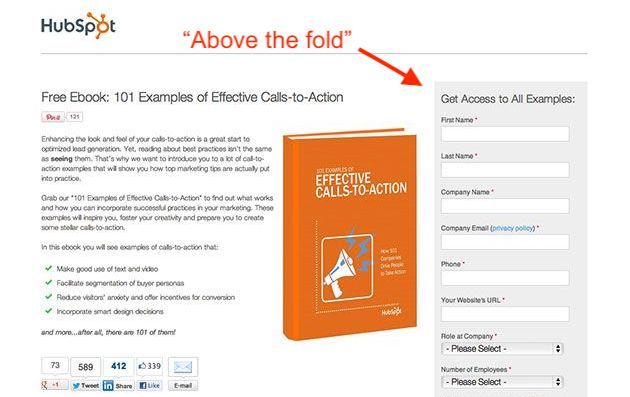Marketers are constantly asked questions like, ‘How are customers engaging with our service?’, ‘Why aren't they engaging?’ and, ‘What can we do differently?’ Fortunately, you can answer all of these questions and many more thanks to metrics.
In this article, we’ll be sharing 20 important metrics for SaaS marketing, ranging from acquisition metrics to monetization metrics. We’ll explain what each metric is, how they can be tracked, and most importantly, why they should be tracked.
1. Leads
Leads are visitors to your website that have filled out a contact form, sometimes in exchange for some free content. They usually submit more than just their email address, showing they’re interested in keeping in touch about your service.
Leads are important metrics because they represent potential customers, by giving them the information they require you can improve the chances of them purchasing your product or service. Leads are usually easy to measure, as you receive their details in order to keep in contact with them.
Here's an example of a lead capture form from HubSpot:

2. Marketing qualified leads (MQLs)
Marketing qualified leads are the third stage in the journey from visitor to customer. These are leads that have shown an interest in both your service and your content. They can be recognized based on the web pages they’ve visited and how they engage with your content overall. For example, if someone's navigated from your home page in order to browse your product pages, they're very likely a new marketing qualified lead.

3. Sales qualified leads (SQLs)
Sales qualified leads are MQLs who have progressed onto the next stage of the customer journey. They meet the requirements of a customer by showing an interest in your service by actively reaching out for your content. This could be in the form of a sales request, or even accessing a free trial.
Once someone becomes a sales qualified lead, they're ready to move forward to the sales team and become an opportunity.
Sales qualified leads are especially important to monitor as they're on the border of transforming from an interested visitor to a fully committed customer. Whether or not this change successfully happens can also have an impact on your conversion rates.
4. Customers
We all know the definition of a customer, someone who has signed on for your service and committed to it for a certain period of time. The customer count can vary depending on the variety of products offered. For example, if you have free products alongside paid content, these can be counted separately or together.
It’s important to track this metric because as a marketer you must be able to assess the conversion rate of leads into customers in order to determine whether or not your marketing strategy is working.

5. Churn
Churn is one of the more negative metrics to track but is absolutely vital to understand. Churn refers to lost customers, which is inevitable for any company. Churn rates can be measured two ways: customer churn, and revenue churn.
Customer churn measures the rate your customers begin to cancel their service subscription. A low churn rate must be maintained in order to grow your service, if it gets too high, this can lead to revenue churn. Revenue churn is the measurement of lost revenue due to customers either downgrading their subscription or canceling it completely.
The easiest way to calculate customer churn is to divide the number of churned customers within a time period by the number of customers that were had at the start of this time period.
(Total customers + New customers - Lost customers) / Lost customers = Churn rate %
Revenue churn can be found a similar way, by dividing the monthly recurring revenue you had at the start of the month and dividing it by the amount you lost that month.
((MRR at the start of the period - MRR at the end of the period) - MRR from upgrades) / MRR at the start of the period
If you want to learn more about churn rates, check out this article.
6. Conversion rates
Conversion rates encompass a wide range of measurements, like how successful is your marketing at turning potential leads, into satisfied customers? While acquiring customers would seem to be the most important goal, this could be made easier by evaluating your conversion rates to speed up the process.
Conversion rates can be tracked using visitors to your website, monitoring how quickly they become potential leads. Once they become leads, you can follow them from MQLs to SQLs until they become a paid customer. Alternatively, you can also measure the conversion rate of free trials into paying customers.

7. Source measurement
Source measurements track how people find your website, whether that’s from referrals on other sites, or people searching for the website themselves.
Knowing the source of your visitors will allow you to evaluate how you are marketing your website and make appropriate changes to give it as much coverage as possible.
Sources can be tracked using google analytics.

8. User rates
User rates track how frequently users return to your website. It’s essential to track users in order to determine how effective your website is, and when combined with other metrics such as sources, it can give you a solid understanding of how successful your site is.
Users can be tracked using the analytical data on your website and can be monitored over any period of time you prefer, whether that’s weekly or monthly.
9. Time spent on the website
Once you determine the amount of users your website is hosting, it’s essential to know how they're interacting with it.
However, depending on the types of pages your displaying, the positive measurement can vary. For example, if you have a page that contains an article or just a lot of information, obviously you’d prefer users to spend longer on that page, but if you have a visual page that doesn’t contain much content, then a shorter time spent on it by users may not necessarily be a bad thing.
The analytical data on your website can track this metric, measuring the time on each page individually or the time on your website as a whole.

10. Bounce rate
The bounce rate is yet another metric you can track using Google Analytics , but it's paramount that it is tracked due to its implications for a website as a whole.
Bounce rates are the metrics that reveal the visitors to your site that only view one page before leaving altogether.
The bounce rate can be influenced by a number of factors, such as how you advertise your website and how you present your content.
A high bounce rate can reveal where your website is lacking and allow you to tailor it to the visitor’s needs. For example, visitors are more likely to delve deeper into your website if you present them with a homepage that's both visually interesting and presents them with the content they require.
11. Opportunities
Opportunities are SQLs who have moved on from your marketing efforts and are now in contact with the sales team.
This is the defining area where your marketing pays off and lands a new customer. As such, it’s important to track not only the steps up to this stage but to monitor the opportunity itself.
If the opportunity successfully becomes a customer, congrats! Your marketing combined with the sales team secured their commitment to your service
12. Free trial requests
Free trials have become a mainstay of the SaaS industry, they provide an opportunity for potential customers to understand exactly what your service can offer and if it’s going to be worth their money.
Leads who use free trials can be seen as MQLs since they don’t require much commitment, but they have the possibility of advancing the conversion from lead to customer. It’s also important to track free trial requests, if you’re receiving numerous free trial requests, but your prospects aren't converting something needs to be reworked.

13. Marketing spend
Marketing can sometimes be quite complex to manage, especially when it comes to funding. Essentially marketers are spending money in an attempt to make money.
Regardless of the strategies you use, it’s vital you monitor your marketing spend. If you spend too much, you risk your strategy not paying off around the sales stage, but spend too little and you risk not promoting your service enough.
A happy medium must be found in order to improve profits, which can be done by budgeting your spend and evaluating what the most important marketing areas are for your company.
14. Customer acquisition cost (CAC)
Customer acquisition cost refers to the amount of money required to acquire a new customer. It’s a metric that can be used in other areas of the company such as sales, but in this case, it’s the money spent on creating a lead through marketing.
If your marketing is costing more than what customers can pay you back, then you need to evaluate your customer acquisition cost in order to justify the money you're spending on marketing.
When monitored alongside marketing spend and customer lifetime value, knowing your customer acquisition cost can reveal the strengths and weaknesses of your marketing strategies.
Customer acquisition cost can be calculated by finding your total marketing and sales spend for a particular period of time, then dividing it by the number of new customers gained during this time.
Cost Spent on Marketing and Acquiring Customers / Number of Customers Acquired = CAC

15. Customer lifetime value (CLTV)
Customer lifetime value can be seen as the other side of customer acquisition cost. Rather than monitoring how much acquiring a new customer will cost, customer lifetime value looks at how much revenue a single customer can give you during their commitment to your service.
Tracking this metric allows you to understand the balance of how much you should spend on a customer based on how much they're spending on you.
Tracking your customer lifetime value also allows you to learn about your customers and determine which ones are the most valuable to your service.
In order to calculate your customer lifetime value, you need to get the totals each customer has spent together and calculate the median. If your average lifetime value is below your acquisition cost you have a retention issue.
16. CLTV: CAC ratio
When you understand both your customer lifetime value and your customer acquisition cost, you’ll recognize how much they rely on each other.
Your CAC only tells you your costs, but combined with your CLTV reveals what you're actually making in profit.
As a whole, you should be aiming for your CLTV to always be higher than your CAC, because if it's the other way around then your company will be losing money on every customer you gain.
To avoid this, you’ll have to decide between either decreasing the CAC or increasing your CLTV. The ideal ratio can change depending on your service, but it’s generally accepted that a ratio of 3:1 is positive.
Understanding this ratio can often signal whether or not you need to make a new marketing strategy.
17. Monthly recurring revenue
Monthly recurring revenue (MRR) is another metric that can be measured in any area of a SaaS business but is particularly important to know as a marketer.
Monthly recurring revenue refers to the amount of revenue that’s generated by customers every month. It allows you to see how your business is growing financially and can help with managing your marketing spend.
Measuring this metric is as simple as summing up your recurring revenue generated by the months customers to arrive at your MRR rate.
MRRt = Σ Recurring Revenuet

18. Lead velocity rate
Similar to the monthly recurring revenue rate, the lead velocity rate also measures the growth of your business. However, instead of tracking finances, it tracks the growth of engagement with your service. This is tracked through the number of leads you acquire, often comparing them to previous months in order to see the differences.
Calculating your lead velocity rate takes slightly longer than other metrics, but it’s still pretty straightforward. First, you need to subtract the amount of current leads from your previous month’s leads then divide that answer by the previous month’s leads before finally multiplying by 100 to get your percentage.
(#) Qualified leads current month -(#) Qualified leads last month ] /(#) Qualified leads last monthX100=(%) Lead Velocity Rate
19. Viral Coefficient
Viral coefficient may seem disconnected from marketing, but it's a helpful metric for any marketer to be aware of. It refers to the process of customer referrals, in particular, it measures the number of new users generated from an existing user.
However, sometimes users need an incentive to invite friends or family to the service, which opens up new opportunities for marketers to promote this referral process.
Keeping track of this metric lets you know if your marketing strategies are successful enough to convince users to generate more users.
In order to find your viral coefficient, multiply your current number of users by the average number of invitations that your users send out. Next, find the percentage of referrals that successfully resulted in a new user. Calculate how many users this percentage represents then divide the number of new users by existing users to find your answer.
Viral coefficient = C x R x CR / 100
C = Number of customers
R = Average number of referrals per customer
CR = Average conversion rate for referrals
20. Customer satisfaction score
Finally, a beneficial metric to track is the customer satisfaction score. While this undoubtedly helps with every area of the company, as a marketer you could use it to your advantage.
This score is found through surveys your customers answer, rating their satisfaction with the product on a numbered scale.
If there's any marketing-related questions on the survey they could give an indicator of how satisfied customers were with how the service was marketed to them.
Another helpful way to utilize the customer satisfaction score is to include it in any future marketing attempts in order to show how successful the service is.

Depending on what kind of service you're marketing, the importance of these metrics may vary. Nevertheless, I hope this list has opened your eyes to just how vital metrics are to your marketing strategy. The metrics you focus on are entirely up to you, but being able to identify all of them will allow you to answer any questions that may come your way.
Want to learn more SaaS metrics? Check out the replay of this year’s SaaS Metrics Summit in our membership area.

